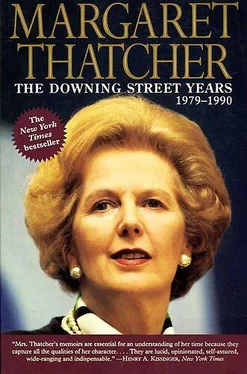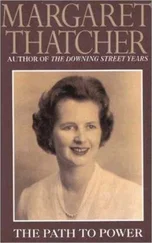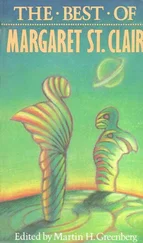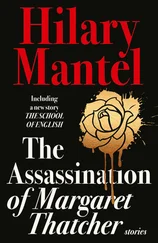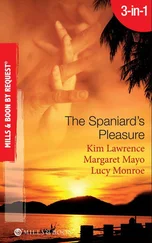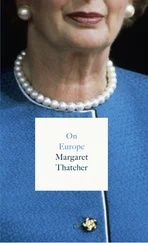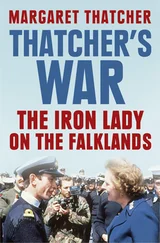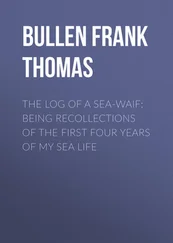As prime minister one has the opportunity to make an impact on the style of No. 10. Outside the flat I had displayed my own collection of porcelain, which I had built up over the years. I also brought with me a powerful portrait of Churchill from my room in the House of Commons. It looked down on those who assembled in the antechamber to the Cabinet Room. When I arrived, this area looked rather like a down-at-heel Pall Mall club, with heavy and worn leather furniture; I changed the whole feel by bringing in bookcases, tables and chairs from elsewhere in the building. There might be some difficult times to come in the Cabinet Room itself, but there was no reason why people should be made to feel miserable while they were waiting to go in.
Although it was not until I had been there some ten years that I had the most important redecorations done, I tried from the start to make the rooms seem more lived in. The official rooms had very few ornaments and when we arrived No. 10 looked rather like a ‘furnished house to let’, which in a way, I suppose, it was. Downing Street had no silver. Whenever there was an official dinner the caterers had to bring in their own. Lord Brownlow, who lived just outside Grantham, lent me silver from his collection at Belton House: it sparkled and transformed the No. 10 dining-room. One particular piece had a special meaning for me — a casket containing the Freedom of the Borough of Grantham, of which both the previous Lord Brownlow and later my father had been Mayor. The gardeners who kept St James’s Park brought in flowers. And happily, the flowers kept on coming, sent by friends and supporters, right until my last days at Downing Street, when you could hardly move down the corridors for a floral display which rivalled the Chelsea Flower Show. I also had the study repapered at my own expense. Its unappealing sage-green damask flock wallpaper was stripped off and replaced by a cream stripe, which was a much better background for some fine pictures.
I felt that Downing Street should have some works by contemporary British artists and sculptors, as well as those of the past. I had met Henry Moore when I was Secretary of State for Education and much admired his work. The Moore Foundation let No. 10 borrow one of his smaller sculptures which fitted perfectly in an alcove in the main hallway. Behind the sculpture was hung a Moore drawing, which was changed every three months; among my favourites were scenes of people sleeping in the London Underground during the Blitz.
I was conscious of being the first research scientist to become prime minister — almost as conscious, in fact, as I was of being the first woman prime minister. So I had portraits and busts of some of our most famous scientists placed in the small dining-room, where I often lunched with visitors and colleagues on less formal occasions.
I felt strongly that when foreign visitors came to Downing Street they should see something of Britain’s cultural heritage. When I came to No. 10 all the paintings in the main dining-room were copies. They were replaced. For example, I was lent a picture of George II, who had actually given No. 10 to Sir Robert Walpole, the first prime minister. On my foreign visits I quickly found that many of our embassies had superb works of art which added greatly to the impression people had of Britain. I wanted foreign visitors to No. 10 to be similarly impressed. I knew that there were large numbers of excellent British paintings in our museums which were not on show. I was able to borrow some Turners, a Raeburn from Scotland and some pictures from the Dulwich Gallery and these were hung in the White Drawing Room and the main reception room. I also had some fine portraits hung of the nation’s heroes; through them you could feel the continuity of British history. I recall on one occasion watching President Giscard d’Estaing gazing at two portraits in the dining-room — one of the young Nelson and the other of Wellington. He remarked on the irony. I replied that it was no less ironic that I should have to look at portraits of Napoleon on my visits to Paris. In retrospect, I can see that this was not quite a parallel. Napoleon lost.
On this first evening, though, I could do little more than make a brief tour of the main rooms of the building. Then I entered the Cabinet Room where I was greeted by more familiar faces — among them my daughter Carol. There was Richard Ryder who had been and would continue for a time as my political secretary, responsible for keeping me in touch with the Conservative Party in the country; David Wolfson (now Lord Wolfson) who acted as my Chief of Staff, bringing to bear his charm and business experience on the problems of running No. 10; Caroline Stephens (later to become Caroline Ryder) who became my diary secretary; Alison Ward (later Alison Wakeham) my constituency secretary; and Cynthia Crawford — known to all of us as ‘Crawfie’ — who acted as my personal assistant and who has stayed with me ever since. We did not waste much time in conversation. They were anxious to sort out who was to go to which office. I had exactly the same task in mind: the choice of my Cabinet.
Choosing a Cabinet is undoubtedly one of the most important ways in which a prime minister can exercise power over the whole conduct of government. But it is not always understood how real are the constraints under which the choices take place. By convention, all ministers must be members of either the Commons or the Lords, and there must not generally be more than three Cabinet members in the Lords, thus limiting the range of potential candidates for office. In addition one has to achieve distribution across the country — every region is easily convinced it has been left out. You must also consider the spectrum of party opinion.
Even so, the press expect the Cabinet of some twenty-two ministers to be appointed and the list to be published within about 24 hours — otherwise it is taken as a sure sign of some sort of political crisis. My American and other foreign friends are often astonished at the speed with which British Governments are formed and announced.
So I do not think that any of us at No. 10 relaxed much that day, which turned out to be a long one. (The previous night I had had no more than a couple of hours’ sleep, if that.) I received the usual detailed security briefing which is given to incoming prime ministers. Then I went upstairs to the study in which I was to spend so many hours in the years which followed. I was accompanied by Willie Whitelaw and our new Chief Whip, Michael Jopling. We began to sift through the obvious and less obvious names and slowly this most perplexing of jigsaws began to take shape. While Willie, the Chief Whip and I discussed the appointments to the Cabinet, Ken Stowe sought to contact those involved to arrange for them to come in the next day.
At 8.30 p.m. we took a break for a meal. Knowing that there were no canteen facilities at No. 10, my personal staff brought in a Chinese meal from a take-away and some fifteen of us sat down to eat in the large dining-room. (That, I think, was the last take-away while I was Prime Minister.)
I knew that the hardest battles would be fought on the ground of economic policy. So I made sure that the key economic ministers would be true believers in our economic strategy. Geoffrey Howe had by now thoroughly established himself as the Party’s chief economic spokesman. Geoffrey was regularly bullied in debate by Denis Healey. But by thorough mastery of his brief and an ability to marshal arguments and advice from different sources, he had shown that beneath a deceptively mild exterior he had the makings of the fine Chancellor he was to become. Some of the toughest decisions were to fall to him. He never flinched. In my view these were his best political years.
Читать дальше
